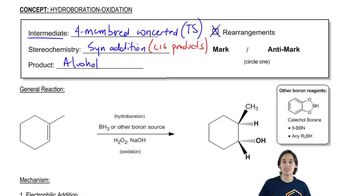Predict the major products of the following reactions.
(c) 2-methylpent-2-ene + BH3⋅THF
(d) the product from part (c) + H2O2/OH−

 Verified step by step guidance
Verified step by step guidance Verified video answer for a similar problem:
Verified video answer for a similar problem:



 6:38m
6:38mMaster General properties of hydroboration-oxidation. with a bite sized video explanation from Johnny
Start learning